《大学英语翻译》课程PPT教学课件(口译)Module 5 Consecutive interpreting
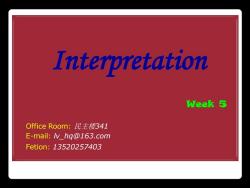
Interpretation Week 5 Office Room:民主楼341 E-mail:Iv_hq@163.com Fetion:13520257403
Interpretation Week 5 Office Room: 民主楼341 E-mail: lv_hq@163.com Fetion: 13520257403
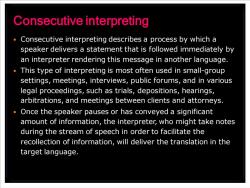
Consecutive interpreting Consecutive interpreting describes a process by which a speaker delivers a statement that is followed immediately by an interpreter rendering this message in another language. This type of interpreting is most often used in small-group settings,meetings,interviews,public forums,and in various legal proceedings,such as trials,depositions,hearings, arbitrations,and meetings between clients and attorneys. Once the speaker pauses or has conveyed a significant amount of information,the interpreter,who might take notes during the stream of speech in order to facilitate the recollection of information,will deliver the translation in the target language
Consecutive interpreting describes a process by which a speaker delivers a statement that is followed immediately by an interpreter rendering this message in another language. This type of interpreting is most often used in small-group settings, meetings, interviews, public forums, and in various legal proceedings, such as trials, depositions, hearings, arbitrations, and meetings between clients and attorneys. Once the speaker pauses or has conveyed a significant amount of information, the interpreter, who might take notes during the stream of speech in order to facilitate the recollection of information, will deliver the translation in the target language. Consecutive interpreting
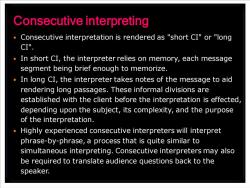
Consecutive interpreting Consecutive interpretation is rendered as "short CI"or "long CI". In short CI,the interpreter relies on memory,each message segment being brief enough to memorize. In long CI,the interpreter takes notes of the message to aid rendering long passages.These informal divisions are established with the client before the interpretation is effected, depending upon the subject,its complexity,and the purpose of the interpretation. Highly experienced consecutive interpreters will interpret phrase-by-phrase,a process that is quite similar to simultaneous interpreting.Consecutive interpreters may also be required to translate audience questions back to the speaker
Consecutive interpretation is rendered as "short CI" or "long CI". In short CI, the interpreter relies on memory, each message segment being brief enough to memorize. In long CI, the interpreter takes notes of the message to aid rendering long passages. These informal divisions are established with the client before the interpretation is effected, depending upon the subject, its complexity, and the purpose of the interpretation. Highly experienced consecutive interpreters will interpret phrase-by-phrase, a process that is quite similar to simultaneous interpreting. Consecutive interpreters may also be required to translate audience questions back to the speaker. Consecutive interpreting
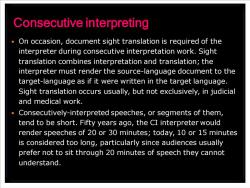
Consecutive interpreting On occasion,document sight translation is required of the interpreter during consecutive interpretation work.Sight translation combines interpretation and translation;the interpreter must render the source-language document to the target-language as if it were written in the target language. Sight translation occurs usually,but not exclusively,in judicial and medical work. Consecutively-interpreted speeches,or segments of them, tend to be short.Fifty years ago,the CI interpreter would render speeches of 20 or 30 minutes;today,10 or 15 minutes is considered too long,particularly since audiences usually prefer not to sit through 20 minutes of speech they cannot understand
On occasion, document sight translation is required of the interpreter during consecutive interpretation work. Sight translation combines interpretation and translation; the interpreter must render the source-language document to the target-language as if it were written in the target language. Sight translation occurs usually, but not exclusively, in judicial and medical work. Consecutively-interpreted speeches, or segments of them, tend to be short. Fifty years ago, the CI interpreter would render speeches of 20 or 30 minutes; today, 10 or 15 minutes is considered too long, particularly since audiences usually prefer not to sit through 20 minutes of speech they cannot understand. Consecutive interpreting
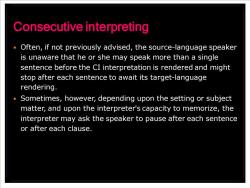
Consecutive interpreting Often,if not previously advised,the source-language speaker is unaware that he or she may speak more than a single sentence before the CI interpretation is rendered and might stop after each sentence to await its target-language rendering. Sometimes,however,depending upon the setting or subject matter,and upon the interpreter's capacity to memorize,the interpreter may ask the speaker to pause after each sentence or after each clause
Often, if not previously advised, the source-language speaker is unaware that he or she may speak more than a single sentence before the CI interpretation is rendered and might stop after each sentence to await its target-language rendering. Sometimes, however, depending upon the setting or subject matter, and upon the interpreter's capacity to memorize, the interpreter may ask the speaker to pause after each sentence or after each clause. Consecutive interpreting
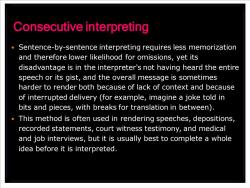
Consecutive interpreting Sentence-by-sentence interpreting requires less memorization and therefore lower likelihood for omissions,yet its disadvantage is in the interpreter's not having heard the entire speech or its gist,and the overall message is sometimes harder to render both because of lack of context and because of interrupted delivery (for example,imagine a joke told in bits and pieces,with breaks for translation in between). This method is often used in rendering speeches,depositions, recorded statements,court witness testimony,and medical and job interviews,but it is usually best to complete a whole idea before it is interpreted
Sentence-by-sentence interpreting requires less memorization and therefore lower likelihood for omissions, yet its disadvantage is in the interpreter's not having heard the entire speech or its gist, and the overall message is sometimes harder to render both because of lack of context and because of interrupted delivery (for example, imagine a joke told in bits and pieces, with breaks for translation in between). This method is often used in rendering speeches, depositions, recorded statements, court witness testimony, and medical and job interviews, but it is usually best to complete a whole idea before it is interpreted. Consecutive interpreting
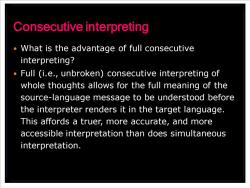
Consecutive interpreting What is the advantage of full consecutive interpreting? Full (i.e.,unbroken)consecutive interpreting of whole thoughts allows for the full meaning of the source-language message to be understood before the interpreter renders it in the target language. This affords a truer,more accurate,and more accessible interpretation than does simultaneous interpretation
What is the advantage of full consecutive interpreting? Full (i.e., unbroken) consecutive interpreting of whole thoughts allows for the full meaning of the source-language message to be understood before the interpreter renders it in the target language. This affords a truer, more accurate, and more accessible interpretation than does simultaneous interpretation. Consecutive interpreting
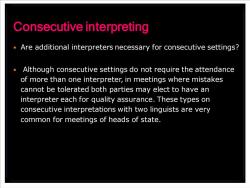
Consecutive interpreting Are additional interpreters necessary for consecutive settings? Although consecutive settings do not require the attendance of more than one interpreter,in meetings where mistakes cannot be tolerated both parties may elect to have an interpreter each for quality assurance.These types on consecutive interpretations with two linguists are very common for meetings of heads of state
Are additional interpreters necessary for consecutive settings? Although consecutive settings do not require the attendance of more than one interpreter, in meetings where mistakes cannot be tolerated both parties may elect to have an interpreter each for quality assurance. These types on consecutive interpretations with two linguists are very common for meetings of heads of state. Consecutive interpreting
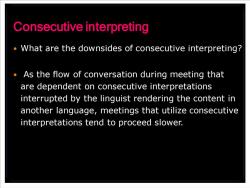
Consecutive interpreting What are the downsides of consecutive interpreting? As the flow of conversation during meeting that are dependent on consecutive interpretations interrupted by the linguist rendering the content in another language,meetings that utilize consecutive interpretations tend to proceed slower
What are the downsides of consecutive interpreting? As the flow of conversation during meeting that are dependent on consecutive interpretations interrupted by the linguist rendering the content in another language, meetings that utilize consecutive interpretations tend to proceed slower. Consecutive interpreting
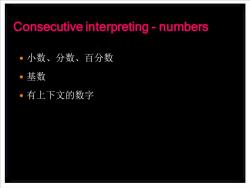
Consecutive interpreting -numbers ·小数、分数、百分数 ·基数 ·有上下文的数字
小数、分数、百分数 基数 有上下文的数字 Consecutive interpreting - numbers
按次数下载不扣除下载券;
注册用户24小时内重复下载只扣除一次;
顺序:VIP每日次数-->可用次数-->下载券;
- 《大学英语翻译》课程PPT教学课件(口译)Module 5 Note-taking(2/2).ppt
- 《大学英语翻译》课程PPT教学课件(口译)Module 6 Simultaneous interpreting.ppt
- 《大学英语翻译》课程PPT教学课件(汉译英)第3讲 翻译中的句式衔接与布局.ppt
- 《大学英语翻译》课程PPT教学课件(汉译英)第1讲 汉译英概论.ppt
- 《大学英语翻译》课程PPT教学课件(汉译英)第2讲 翻译中的形合与意合.ppt
- 《大学英语翻译》课程PPT教学课件(汉译英)第4讲 词性转换.ppt
- 《大学英语翻译》课程PPT教学课件(汉译英)第6讲 长句的翻译.ppt
- 《大学英语翻译》课程PPT教学课件(汉译英)第7讲 公示语和翻译中的文化.ppt
- 《大学英语翻译》课程PPT教学课件(汉译英)第5讲 信息结构与翻译.ppt
- 《大学英语翻译》课程PPT教学课件(英译汉)Unit 2 Diction.ppt
- 《大学英语翻译》课程PPT教学课件(英译汉)Unit 4 Omission.ppt
- 《大学英语翻译》课程PPT教学课件(英译汉)Unit 3 Amplification.ppt
- 《大学英语翻译》课程PPT教学课件(英译汉)Unit 1 Translation Criteria.ppt
- 《大学英语翻译》课程PPT教学课件(英译汉)Unit 7 Passive Voice.ppt
- 《大学英语翻译》课程PPT教学课件(英译汉)Unit 8 Affirmative vs negative.ppt
- 《大学英语翻译》课程PPT教学课件(英译汉)Unit 5 Conversion.ppt
- 《大学英语翻译》课程PPT教学课件(英译汉)Unit 6 Restructuring.ppt
- 《大学英语翻译》课程PPT教学课件(英译汉)Unit 10 Attributive clauses.ppt
- 《大学英语翻译》课程PPT教学课件(英译汉)Unit 13 Long sentences.ppt
- 《大学英语翻译》课程PPT教学课件(英译汉)Unit 9 Splitting.ppt
- 《大学英语翻译》课程PPT教学课件(口译)Module 5 Note-taking(1/2).ppt
- 《大学英语翻译》课程PPT教学课件(口译)Module 3 memory, retelling & summarizing.ppt
- 《大学英语翻译》课程PPT教学课件(口译)Module 2-3 sight translation(C-E).ppt
- 《大学英语翻译》课程PPT教学课件(口译)Module 4 Escort & liaison interpreting.ppt
- 《大学英语翻译》课程PPT教学课件(口译)Module 3 memory & summarizing.ppt
- 《大学英语翻译》课程PPT教学课件(口译)Module 2-1 sight translation(specific skills).ppt
- 《大学英语翻译》课程PPT教学课件(口译)Module 2-2 sight translation(speed control).ppt
- 《大学英语翻译》课程PPT教学课件(口译)Module 1 Introduction to interpreting course & lead-in.ppt
- 《大学英语翻译》课程PPT教学课件(口译)Module 4 Escort & liaison interpreting(Exercise).ppt
- 《大学英语》课程教学大纲(College English).pdf
- 《大学英语教程》课程教材配套电子教案(PPT教学课件,北大版)第一册 第四单元.pptx
- 《大学英语教程》课程教材配套电子教案(PPT教学课件,北大版)第四册 第八单元.pptx
- 《大学英语教程》课程教材配套电子教案(PPT教学课件,北大版)第一册 第三单元.pptx
- 《大学英语教程》课程教材配套电子教案(PPT教学课件,北大版)第四册 第四单元.pptx
- 《大学英语教程》课程教材配套电子教案(PPT教学课件,北大版)第一册 第二单元.pptx
- 《大学英语教程》课程教材配套电子教案(PPT教学课件,北大版)第三册 第一单元.pptx
- 《大学英语教程》课程教材配套电子教案(PPT教学课件,北大版)第三册 第三单元.pptx
- 《大学英语教程》课程教材配套电子教案(PPT教学课件,北大版)第三册 第二单元.pptx
- 《大学英语教程》课程教材配套电子教案(PPT教学课件,北大版)第三册 第八单元.pptx
- 《大学英语教程》课程教材配套电子教案(PPT教学课件,北大版)第三册 第七单元.pptx
